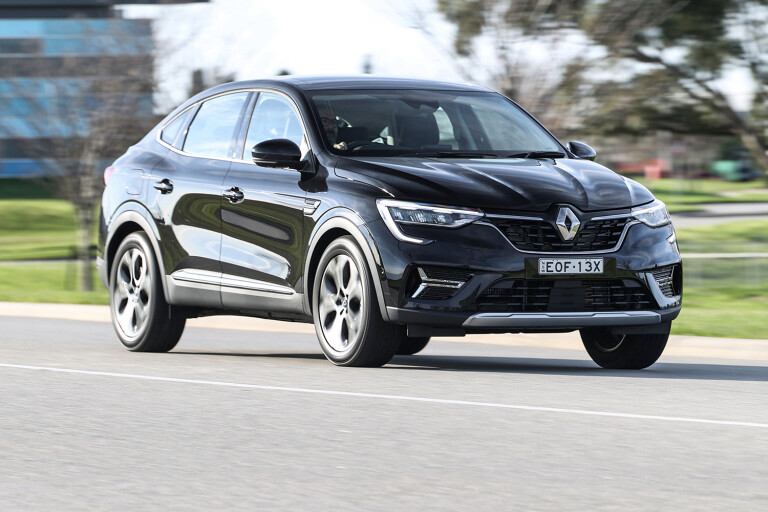
Score breakdown
Things we like
- Ride and handling
- Infotainment
- Fuel economy
- Boot space
Not so much
- Engine and transmission lag
- Styling is a bit of a mixed bag
- Performance doesn't match the looks
- Tight second row
Coupe SUVs, also known as Sports Activity Coupes, have become increasingly popular since BMW first launched the X6 in 2007.
For the cynics among us, this niche segment represents the worst of both worlds – SUV handling with coupe (im)practicality. However, there are obviously a lot of half glass-full people who see them as offering a dynamic driving experience without compromising SUV space and comfort.
These include the good folk at Renault, who have brought the Arkana swept-back small SUV to the Australian market as a more affordable option for anyone with tickets on the BMW X2 or Audi Q3 Sportback.

While it is a rival of sorts to the pricier X2, the Arkana’s gangly appearance reminds me more of the bigger X4.
Like the BMW it looks a little odd at first but soon grows on you, though it’s not quite “seductive” as Renault likes to describe it.
We jumped in the mid-spec Renault Arkana Intens to see if it satisfies the demand for a relatively affordable, stylish European-designed (it’s made in South Korea) coupe SUV with the right mix of practicality, comfort and driver enjoyment.
Does it fit the brief? Read on.

What is the Renault Arkana like to live with?
The Arkana joins the Captur light SUV and mid-sized Koleos in Renault’s local range, and bridges the pair in terms of size and pricing.
It is priced from $33,990 before on-roads for the entry-level Arkana Zen, with this mid-spec Intens priced at $37,490, which is $3500 less than the range-topping RS-Line.
That price range puts the Arkana in direct competition with the other turbocharged small SUVs, including Euro-branded ones such as the Peugeot 2008, Skoda Karoq and the Volkswagen T-Roc.

"While new to Australia, this version of the Arkana was first launched overseas in early 2020"
Its sweptback roof is unique to Renault SUVs, but the front-end is very recognisable, with the fang-like C-shaped DRLs and grille treatment shared with the Captur crossover and Megane hatchback.
The Arkana's high ride height makes it look a little ungainly from the rear, but the LED strip tail-lights flanking the diamond Renault badge add a sense of elegance.
Exterior garnish unique to the Intens includes dual chrome exhaust tips and trim highlights, and 18-inch dual-colour alloy wheels.
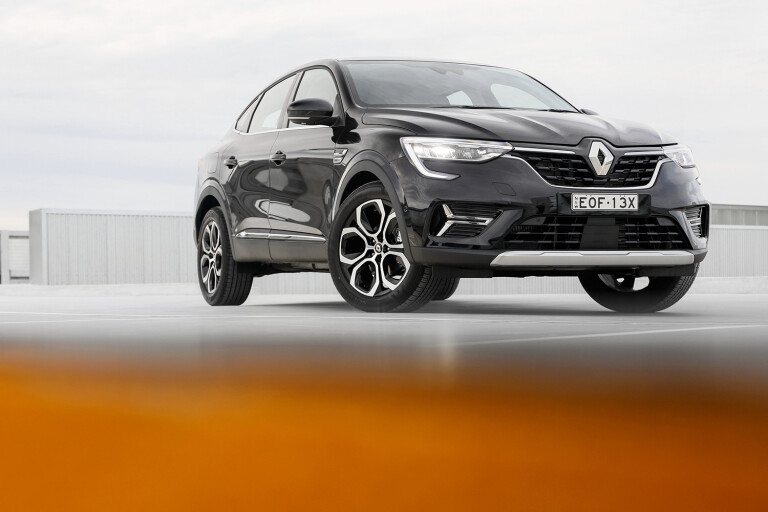
Inside, the $3500 spent over the Zen brings a bunch of additions to the standard features list including premier leather and suede interior trim, power-operated heated and ventilated front seats, additional safety features (see below), a seven-inch digital driver display, and a bigger 9.3-inch portrait touch screen with inbuilt satellite navigation.
Extra-cost options available for the Arkana Intens include a 10.25-inch full-digital driver display, sunroof and metallic paint.

As well as Apple CarPlay or Android Auto smartphone pairing, the portrait touchscreen also displays Renault’s Multi-Sense system with three customisable driver modes; Eco, Sport and the default My Sense. It offers the ability to customise steering feel and choose from eight ambient lighting and driver display cluster colours for each drive mode.
To select a different mode while driving, simply press the (*) button below the screen to bring up the Multi-Sense menu and select the desired mode you want on the touchscreen – this is simple enough to do while driving, though you can cycle through the modes using the button if reaching for the screen isn’t convenient.
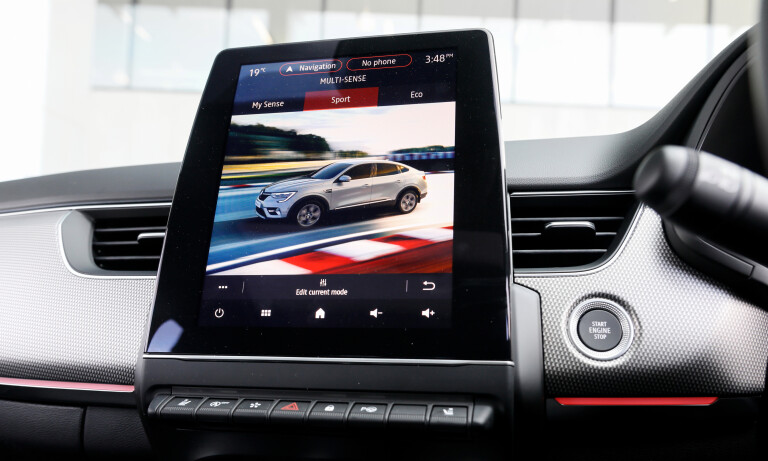
The heated leather steering wheel feels good and features intuitive adaptive cruise control buttons and paddleshifters. Being a Renault, the audio controls are on a separate stalk and can be a little fiddly to operate at first, but you’ll soon get used to it.
An elegant cabin design is similar to other Renault models, but while it feels fresh and looks very presentable it isn’t exactly revolutionary.
The front seats offer good elbow room, with a nice high centre console separating driver and passenger. The storage tub on the centre console is quite small, but with 26 litres of storage spread throughout the cabin you should be able to find somewhere to put stuff.

The rear seat space is a little wider than the front and the seatbacks are angled to increase legroom for this small SUV. However, things can be a little tight, despite Renault’s claim the Arkana can seat three adults across the back in comfort. I’m about average height, and with the driver’s seat in my position, my knees are touching the sculpted front seatback.
Taller people will find fitting back there a challenge and the swept-back roofline will impinge on their headroom too.
Rear-seat passengers are treated to two USB ports, air vents, map pockets, generous door bins and a fold-down centre armrest with cupholders.

The roofline doesn’t really hinder boot space unless you want to carry tallish items. The 485-litre capacity is right up there for a small SUV and is bigger than some mid-sizers including the Mazda CX-5 and Mitsubishi Outlander.
Its split-level floor has 970 square millimetres of surface area so will easily hold a couple of large suitcases and then some. It can also be adjusted for easy loading with a flat bottom in line with the boot lip or deeper load area to maximise space.
The rear seats fold separately with a 60:40 split to provide about 1700 millimetres from the load lip to the front seats.
The Arkana is covered by a five-year unlimited-kilometre warranty. You can also receive five years of fixed-price servicing and five years of free roadside assistance if the vehicle is maintained at a Renault service centre.

What is the Renault Arkana like to drive?
Each Arkana variant is powered by a torquey 1.3-litre four-cylinder turbocharged TCe 155 engine that was co-developed with Mercedes-Benz and is found in the A-Class.
It’s also the same engine found in the Captur, but with slightly different outputs – the Arkana pulling 115kW/262Nm compared to the Captur’s 113kW/270Nm.

And like the Captur, it’s paired with a seven-speed dual-clutch automatic transmission that sends power to the front wheels.
Just like the Captur and Mercedes-Benz A180 is a little slow off the mark thanks to a combination of little low-range power and the laggy dual-clutch auto.
Sport mode helps overcome lag with initial higher revs to give you a better kick-off and, when you plant the foot, will take the tacho to redline before kicking down for some late zip, but not enough to get you from 0-100km/h in less than its rather pedestrian 9.1-second official claim.
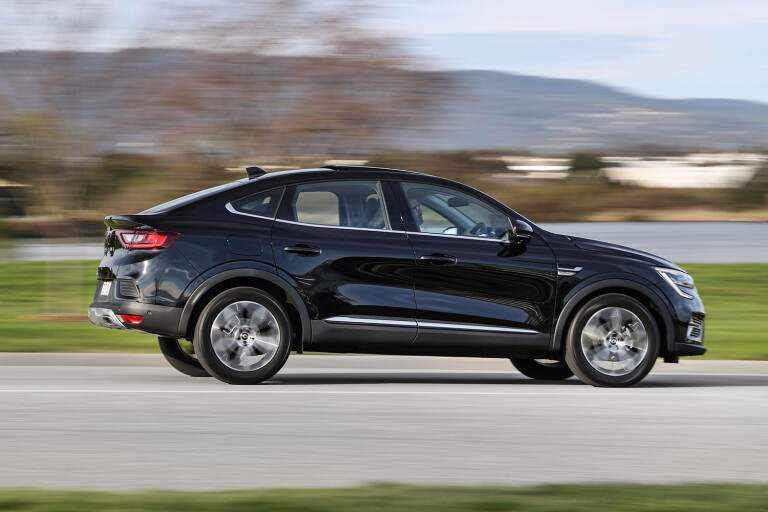
What the Arkana’s powertrain doesn’t want for is torque, which provides good pick up when you’re fully loaded. On the downside, it does exhibit torque steer when taking off in Sport mode where you’ll experience substantial front wheel spin in the wet.
The engine can sound a little thrashy above 3500 rpm but it settles well once you get going, making for a quiet ride and regardless of which driving mode you’re in there is good mid-range power for overtaking.
Road and wind noise are also well filtered, with the latter aided by the aerodynamic-shaped roof that also helps the Arkana achieve a frugal official combined fuel consumption of just 6.0L/100km.
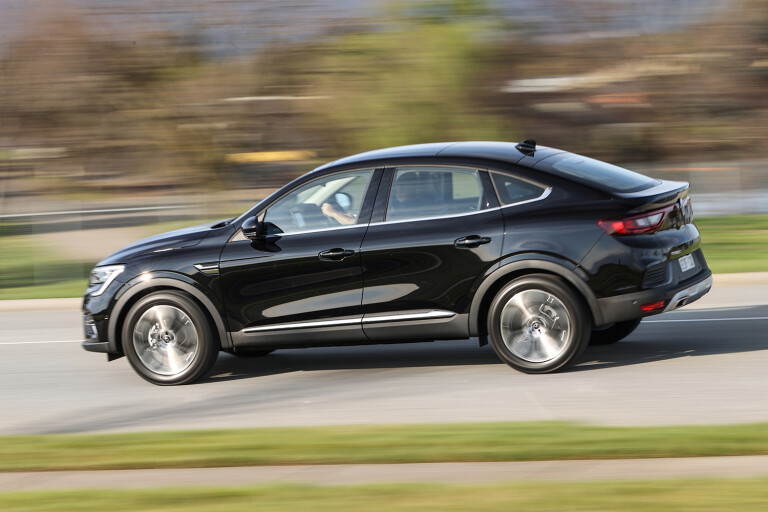
Where the Arkana surprised and delighted me most was with its handling. On its 2720mm wheelbase and 1562mm/1584mm front/rear tracks, it feels well planted to the road and you always feel a sense of control thanks to the steering that, even in regular mode, feels tight and responsive.
If you want the tiller to feel lighter, say for parking, you can select a comfort setting for either drive mode.
One issue with the steering is its self-centring mechanism that sees the tiller spring back to the straight position. I don't mind it, but it probably won't be everyone's cup of tea.
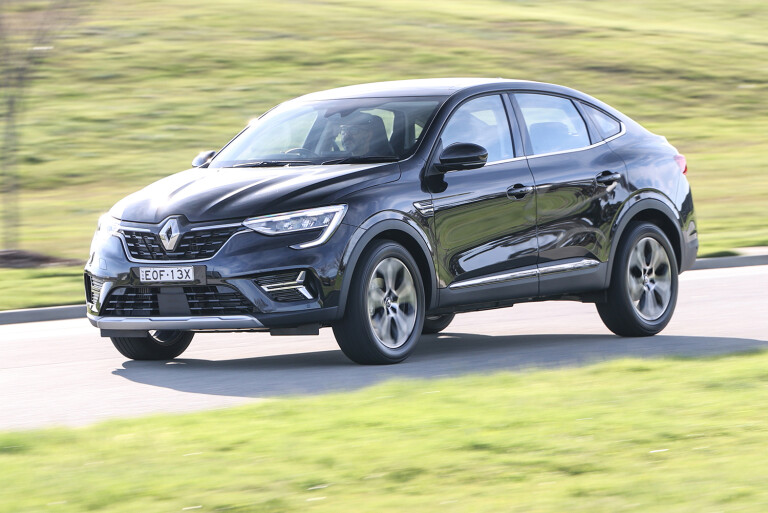
The direct steering is backed up by reasonably tight handling, which benefits from the Arkana being built on the Nissan Renault Mitsubishi Alliance’s Common Module Family, B-Segment (CMF-B) platform that also underpins the Captur and Nissan Juke.
As well as providing additional space, the CMF-B is lighter and tauter than previous Renault SUV underpinnings. As a result, the Arkana feels balanced during aggressive turning and there is even weight distribution across the front axle so it feels stable when you experience body roll.
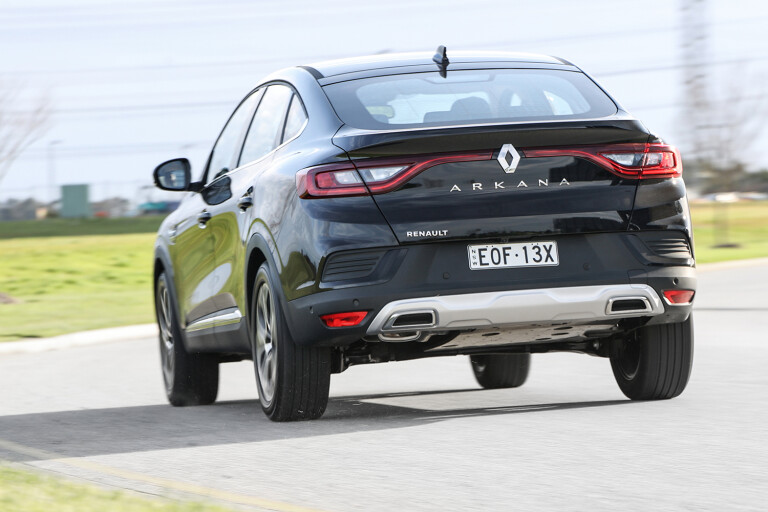
At the same time, ride quality on the MacPherson strut front and torsion beam rear suspension feels a little firm but comfortable enough and is well-tuned to provide a good balance between ride and handling for most road conditions, with occasional jarring over potholes.
The 199mm ground clearance allows the Arkana to travel capably over rougher roads, front-wheel-drive traction permitting, and there is good under-body protection at each end.
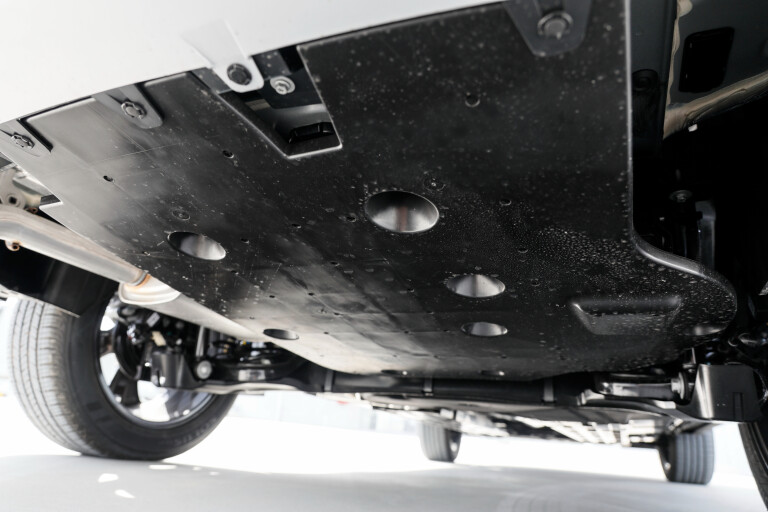
What is the Renault Arkana Intens like for safety?
Safety-wise, the CFM-B platform has allowed Renault to introduce more active safety features to its newer models including Arkana, such as AEB with cyclist and pedestrian detection, lane-keeping assist, traffic sign recognition, blind-spot warning and adaptive cruise control with stop and go.
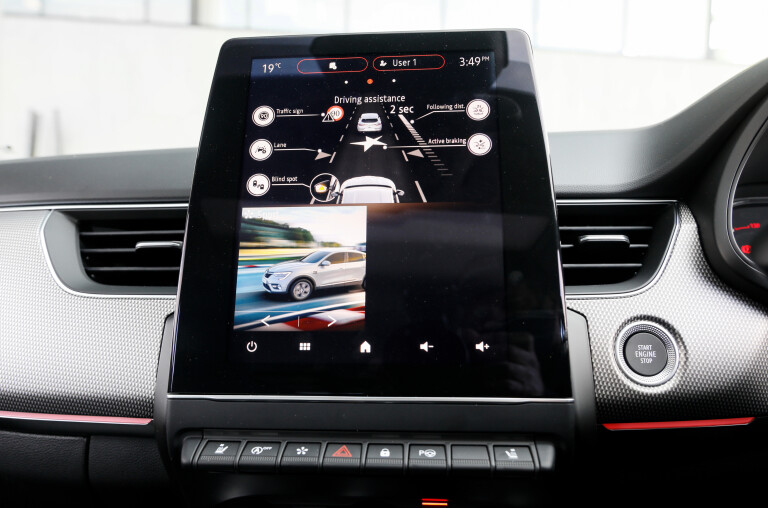
Other standard driver-assist features include auto high-beam headlights, surround parking sensors, and hands-free Easy Park Assist – with the Intens bringing rear-cross traffic alert and a smart speed limiter that will limit your speed based on traffic sign recognition.
There are five airbags, including first-row front and side bags, and curtain bags across both rows.
Based on its similarities to the new Renault Captur that had previously earned a top safety score, the Arkana has a five-star ANCAP safety rating as of July 2021.
VERDICT
Even with Renault’s hot hatch pedigree, I was quite surprised how much I enjoyed driving the Arkana through the undulating terrain around central Victoria.
As we saw with the new Captur, the CFM-B platform represents a huge dynamic improvement over the ageing Nissan chassis that underpins the rather bland Koleos and now-discontinued Kadjar.
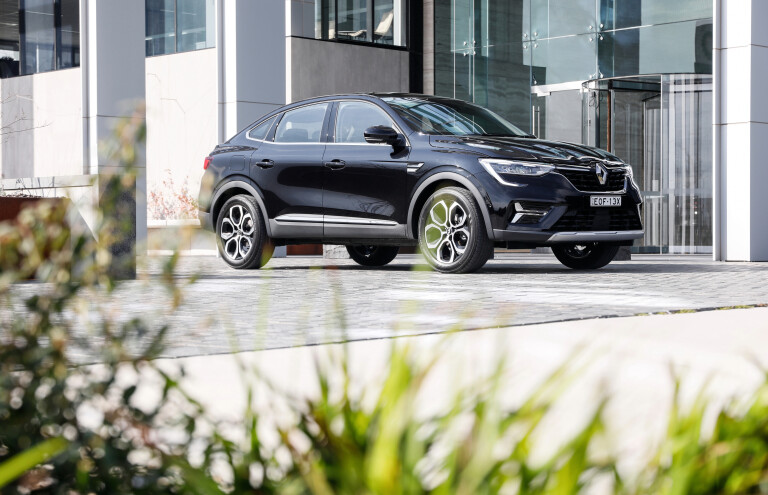
I quite enjoyed driving the Captur, but the Arkana takes driveability a step further thanks in part to its sleek profile, which is more than just an aesthetic exercise.
It’s a handy SUV too, and that balance between practicality and driver enjoyment could see it do relatively well in Australia, with the Intens bringing enough extras over the Zen to make it the sweet spot of the range.

2022 Renault Arkana Intens specifications
| Body: | Five-door small SUV |
|---|---|
| Drive: | FWD |
| Engine | 1.3-litre four-cylinder turbo petrol |
| Transmission | Seven-speed dual-clutch automatic |
| Power: | 115kW @5500rpm |
| Torque | 262Nm @ 2250Nm |
| Bore stroke (mm): | 72.2 x 84.4 |
| Compression ratio: | 10.5 |
| 0-100km/h | 9.1sec (claimed) |
| Fuel consumption: | 6.0L/100km |
| Weight: | 1358kg |
| Suspension: | MacPherson strut front/Torsion beam rear |
| L/W/H: | 4568mm/1821mm/1571mm |
| Wheelbase: | 2720mm |
| Brakes: | 280mm front/260mm rear discs |
| Tyres: | 215/55 R18 Kuhmo Solus |
| Wheels: | 18x7.0 alloy |
| Price: | $37,490 + ORC |
Score breakdown
Things we like
- Ride and handling
- Infotainment
- Fuel economy
- Boot space
Not so much
- Engine and transmission lag
- Styling is a bit of a mixed bag
- Performance doesn't match the looks
- Tight second row

COMMENTS